4. Bird Brains - Skill Set
There is increasing evidence that the disparaging term "bird brain" may turn out to be a compliment rather than an insult. This section looks at how evolution has led to a surpising level of intelligence in birds coupled with a skill set that is way beyond human capability.
Cognitively Challenged?
The traditional view of birds as creatures of very little brain is rooted in behaviour that may well appear cognitively challenged. Take for instance, the southern ground hornbill, a threatened species. It is a slow moving, diurnal forage and because of its considerable size, very conspicuous. It has a very low "flight initiaton distance" (see Bird Watch chapter) and prefers ambling to soaring. It is often on the menu labelled "bush meat" or, in the pharmacy, on the shelf labelled "tribal medicines". Like so many species, t seems to belong to an era when their were fewer human predators around and it has not adapted well to the new conditions.

Southern Ground Hornbill
Definitely not the brightest bird in the bush but very approachable for a good photo opportunity. Fortunately this specimen is well protected in Kruger National Park.
A Long Time Evolving
Birds and mammals have a common 320 million year old reptilian ancestor. From that point in time, the two lineages diverged following separate evolutionary pathways. We are unlikely to know what the brain of this common ancestor looked like but it may well have shared features of both birds and mammals which have since evolved totally different brain anatomies but with similar cognitive function and learning ability, another example of convergent evolution.
Bigger is not Necessarily Better
In birds, the cerebral cortex is proportionally smaller than mammals, because they have to have small light heads to enable flight. However, the connectivity between various parts of the brain leaves mammalian brains far behind. Birds also have more brain cells (neurons) than mammals. In fact, songbirds and parrots have twice as many neurons as primates of the same mass and the difference increases for large parrots and covids such as crows and magpies. And whereas mammals stop producing new brain cells when they reach adulthood, birds can shed and create brain cells throughout their lives and therefore have brains that are more resistant to aging and can sustain the ability to learn.
In practical terms, there is evidence that birds can form abstract concepts, remember the past, plan for the future and make tools.
The Skill Set
Before proceeding to examples of bird intelligence, it's worth recapping on the broad skill set that establishes their superior position in the animal hierarchy.
Flight
We looked at bird flight in the Feathers chapter and noted their exquisite mastery of the skies achieved through fine motor control of tail, wings and body and responses to the slightest changes in air pressure and air currents. Is there a human equivalent? Perhaps the perfection of balance and movement of a trained ballet dancer or an Olympic gymnast?
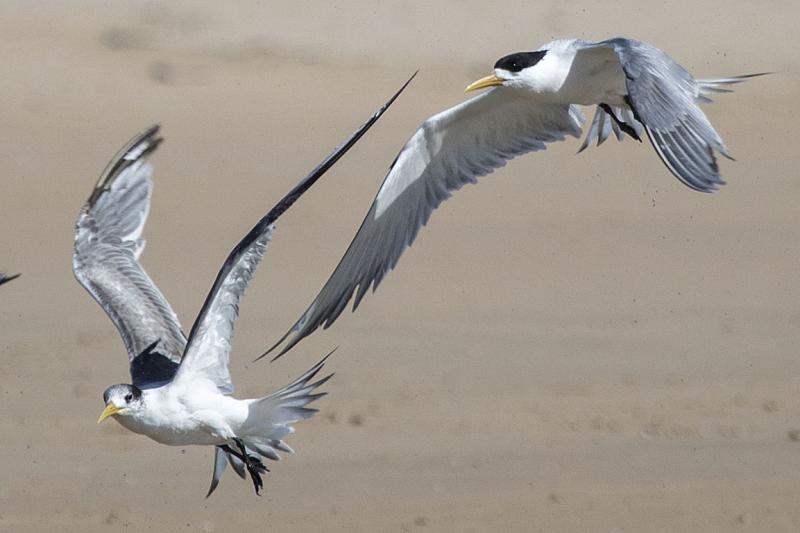
Greater Crested Tern
Upstroke and downstroke. These great-crested terns demonstrate their high speed take-off and maneuverability at the Goukamma River Estuary, Western Cape, South Africa.
Bird Song
Inspiring
Did birds teach us to sing? Very likely as we have been around for a mere 40,000 years, whereas birds, as we have learnt, have been here for millions of years. From our early ancestors to present day homo sapiens we have been enjoying bird song and the creative spark it ignites. Mozart found musical inspiration in his pet starling while Olivier Messiaen blended together the elements of a dawn chorus, in "Oiseaux exotiques", combining exact musical notation with avian melodies. Bird melodies have also been interpreted by pianos, flutes, oboes and xylophones in works by the likes of Haydn (The Seasons) and in Beethoven's sixth symphony.
How do Birds Sing?
Songbirds have a "Syrinx" a vocal chamber with doube the sound equipment of the human larynx enabling complex sound combinations, In addition, birds have totally different respiratory organs with large air sacs that enable them to exhale and create song for long periods without pausing, switching between chambers in their double barrelled sound system. Additionally, birds make "mini breaths," which last a fraction of a second so there appears to be no break in the song but is sufficient to replenish their air supply.

Cape Rock Thrush
Example of the learnt bird song of a passerine, in this case the cape rock thrush from the Robberg Penninsula, Western Cape, South Africa. The purpose is to proclaim terrritorial rights and to attract and retain a mate.
Bird songs and bird calls are different with calls having a very specific meaning, often related to a threat.
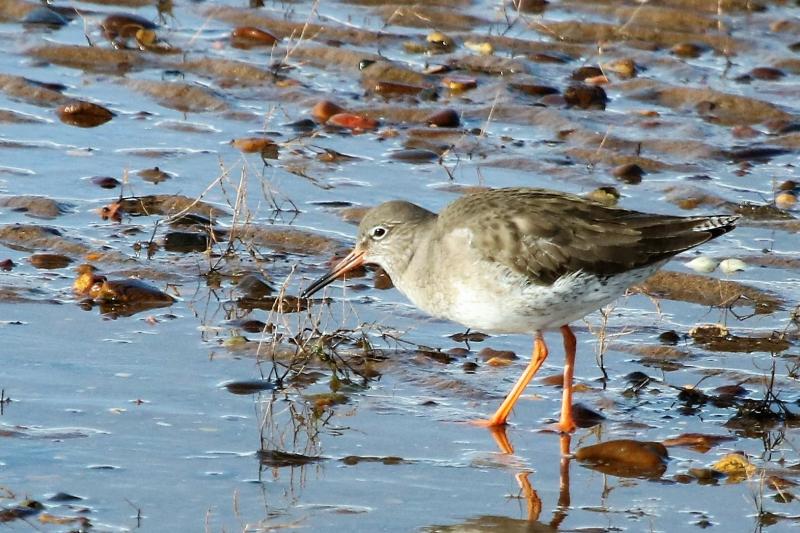
Common Redshank
This warning call of the common redshank. Photographed in the Exe Estuary, South Devon, UK.
Not all Birds Sing
There are variations in the the location and structure of the syrinx resulting in considerable differences in the range, complexity and size of repertoire between species. Passerines, the perching birds (see "What is a Species?" section), are also known as the song birds and have syrinxes capable of the most versatility while many other species have a limited range of relatively unmusical calls.
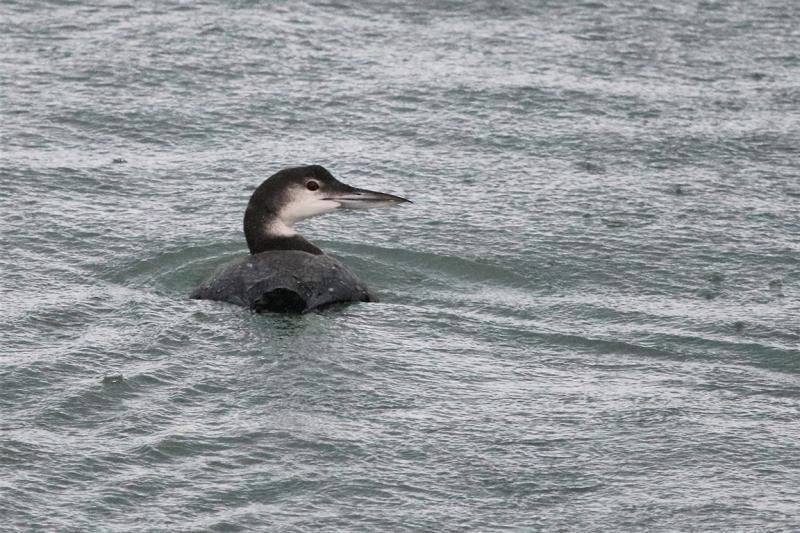
Great Northern Diver
The haunting, but rather limited and unmusical call of the Great Northern Diver photographed at Brixham Breakwater, South Devon, UK. Probably an inherited trait rather than a learnt behaviour.
Learnt Behaviours
What is intriguing is that although the calls are generally innate and known from birth, songs are learnt by young birds over several months or even years and that the complexity of a species' song is directly related to the time spent by adults nurturing and teaching their young. The function of musicality in bird song is difficult to understand. Did birds evolve a need to make music in the same way as humans? There appears to be a link between the complexity of song and cognitive ability which is understood by females who select their mates accordingly. Thus bird song and natural selection are intimately connected. The genes for higher cognitive ability manifest through complex and sustained bird song. The genes that create more caring parents enable the chicks with higher cognitive function to learn bird song more effectively. So evolution has produced adaptations that ensure the transfer of genes to the gene pool of traits linked to both cognitive ability and good parenting skills.
There is more about bird song in the mating section.
Nest Building
A Learning Curve
Once thought to be an innate, inherited ability, recent research shows that nest building is in fact a skill that is learnt and improves with practice. Weaver birds, which build the most complex nests, use different approaches from one member of the species to another and also develop their technique as they construct more nests, dropping fewer pieces of grass and weaving more sturdy structures. As the males build the nest in order to attract a mate, this is further evidence of the evolution of the weaver's ability to learn in order to perpetuate his genes. If the female rejects his efforts, which they often do, then it is probably a sign that the male lacks desirable skills. However, as the male will build several nests during a season, he has a chance to prove that he has learnt from his failures and has the intelligence to contruct a more acceptable home for his partner and children.

Cape Weaver
This cape weaver in Montagu, Western Cape, South Africa seems to have mastered the art of nest construction and deserves every success in attracting a mate.
Migration
How do Birds Migrate?
Scientists are still divided as to how some species of birds can travel thousands of miles navigating unerringly and arriving at the same locations year after year. The reason for this uncertainty is understandable. Because we lack the basic sensory tools available to birds, we struggle to comprehend skills entirely outsided the experience of homo sapiens whose ancestors began to evolve in a different direction 310 million years ago. Scientists are agreed that birds have some sort of internal global positioning system (GPS) without the massive technological support system that we need to achieve similar results. Laboratory experiments with birds (some involving hideous sensory deprivation) have supported, variously, navigation by the position of the sun, by star constellations, by the earth's magnetic field and by using physical landmarks. And maybe a combination of all of these. Young birds migrating for the first time without their parents, can successfully navigate across vast distances, although unlike their parents, they cannot pinpoint a specific location, and they have to find their own territory to which they return in following years. Thus a species' GPS sysem is inherited, an evolutionary wonder driven by the need to survive in a highly competitive environment.
Obligate and Facultative Migration
"Obligate migation" is the name given to birds that are hard wired to migrate every year and the species so driven are in the minority. Only about 1,800 out of 10,000 bird species are driven by instinct to migrate every year before and after the cold season to take advantage of food supplies and to avoid extreme weather conditions. The majority of bird species either do not migrate, migrate short distances and/or engage in "facultative migration" which involves moving only when necessary, for instance, in response to drought or food shortages. This type of migration involves choice and initiative and not instinct.
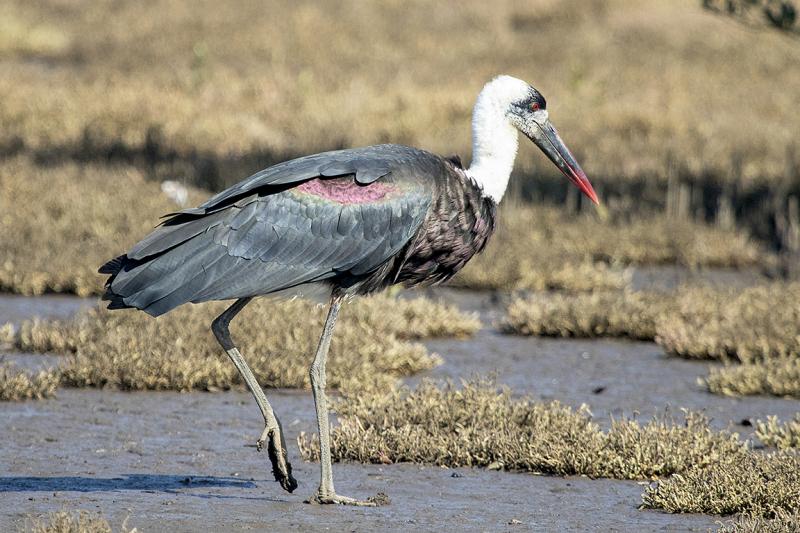
Woolly-necked Stork
A Facultative Migrant
This woolly-necked stork photographed in St Lucia Wetlands, Kwa-zulu Natal, South Africa, is a facultative migrant choosing when to relocate for breeding and water and food supply.
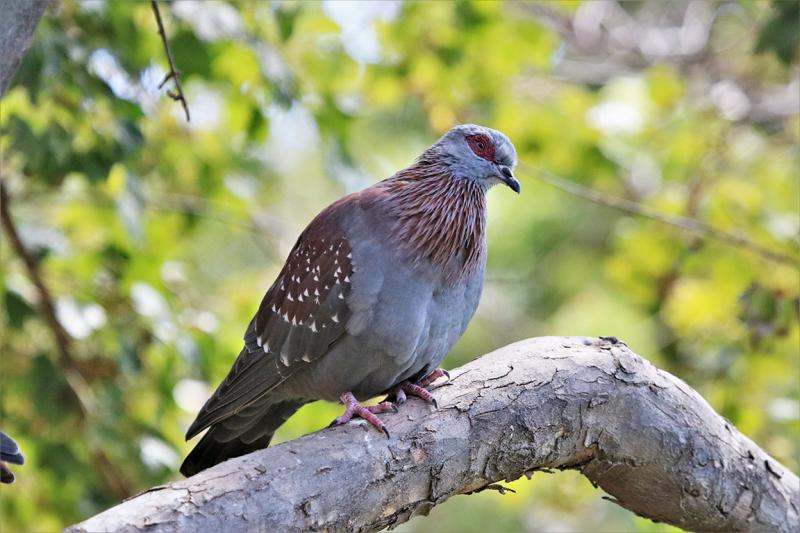
Speckled Pigeon
A Sedentary Bird
A resident widely distributed across sub-Saharan Africa, this speckled pigeon rarely travels from its chosen territory. It is "sedentary".
Why Migrate?
At first glance there appears to be no incentive to leave the easy life of a tropical or sub-tropical environment with accommodating climate and apparently abundant food source. However, competition is a major factor driving birds to leave their winter quarters and head North (or South in the Southern Hemisphere). The energy consumed by migration is offset by the energy intake available in the summer quarters where there is less competition from other species. Hence many species will travel thousands of miles to their summer breeding grounds as they are able to find sufficient food for their young without competing with hundreds of other species in bio-diverse regions further South (or North).
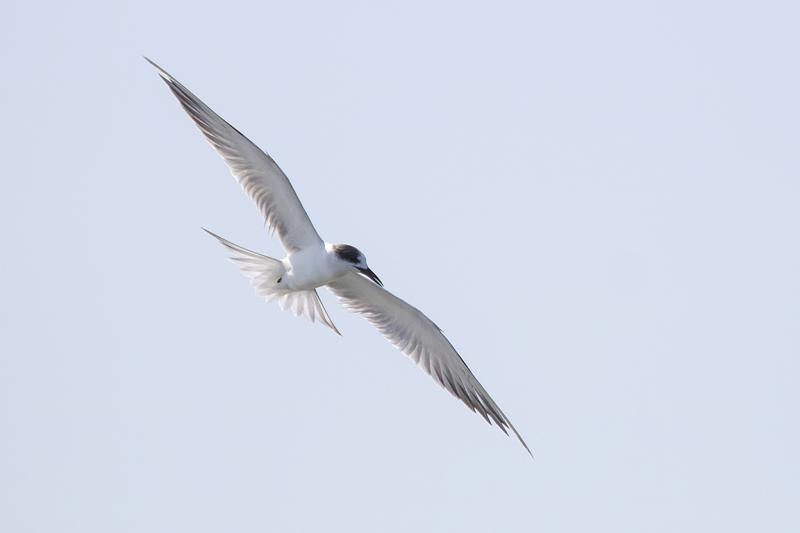
Common Tern
An Obligate Migrant
This common tern winters in the Gulf of Thailand and makes a 20,000 kilometre round trip every year.
Migration routes are complex. The Arctic tern is the greatest exponent of long distance migration, travelling from its nesting site in the Arctic, before the grim, dark, cold winter begins, to the Antarctic summer, a journey of more than 30,000 kilometres. The common tern photographed above in the Gulf of Thailand will fly to its summer breeding site in temperate Europe or Asia every March, a journey of around 10,000 kilometres.
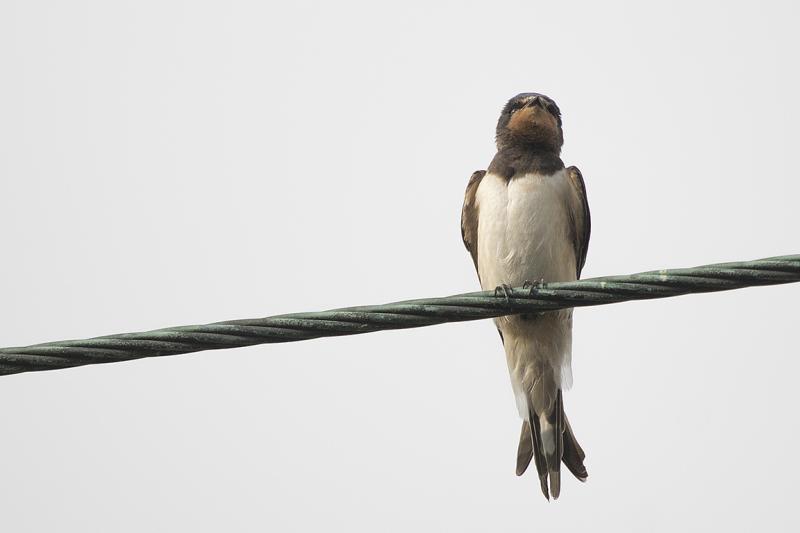
Barn Swallow
An Obligate Migrant
This barn swallow will fly from Scotland where this photograph was taken in July, to South Africa when Autumn arrives, another journey of around 10,000 kilometres. There is a very different migration route for the Brent Goose. After the swallow has left, the brent goose arrives in UK for the winter having spent the summer in its breeding grounds in Northern Russia.
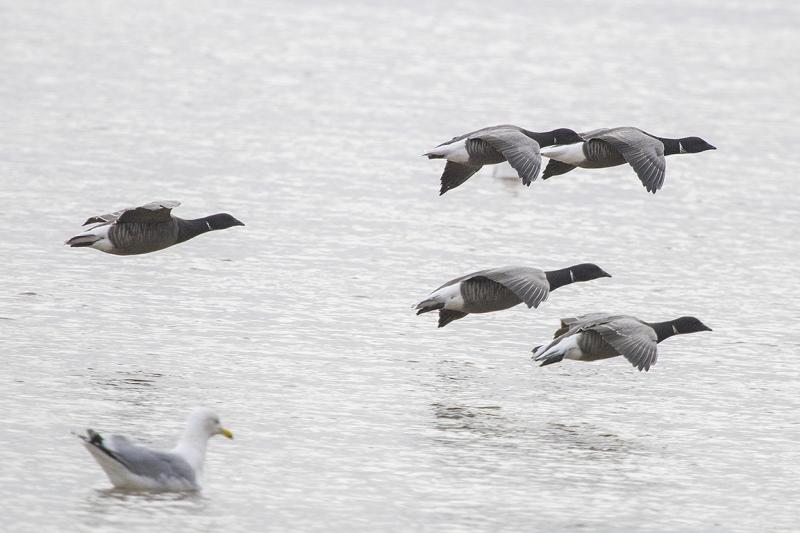
Brent Goose
An Obilgate Migrant
These migration patterns have evolved over the millenium with each species adapting its behaviour according to its best chances of survival in a highly competitive world.
Intelligence and Migration
Studies of species that migrate have revealed a surprising fact. Given the enormous challenges of navigation across the planet we might expect the long distance fliers to be amongst the cleverest problem solvers of the bird world. In fact, birds that do not migrate and experience seasonal changes are often the ones with the most complex brains and largest craniums relative to size. Apart from the ingenuity required to thrive in adverse conditions, sedentary species do not require the careful control of weight and volume necessary for long migrations. Migratory species have smaller, lighter brains, an evolutionary trade-off that increases the likelihood of successful migration.